This past weekend I spent a couple days in Berlin with Ali, a friend also in the BEDA program here in Madrid. We had a 3-day weekend and decided to plan a trip together and ended up choosing Berlin primarily due to cheap flights. After factoring out travel time we essentially had two full days in Berlin, which we tried to fit in as much as humanly possible. While we didn’t have any initial goals, the trip ended up turning into a mixture of exploring the city (and it’s history) and eating lots of good food. Berlin is a very cosmopolitan and international city so we took advantage of that fact by searching out things we can’t easily get in Madrid (read: coffee!). Unfortunately a day before leaving Ali started feeling sick, so we had to relax our pace a bit, but nonetheless it was an amazing trip! Berlin easily joins London as a city in Europe I could easily see myself living in someday.
We flew out Thursday evening, and already started off the trip on a memorable note: much like my London trip, we came within minutes of missing our flight. After rushing from work to the airport, getting through security, and Ali wanting to grab a quick snack before boarding, we rushed to the gate only to see the sign read “BOARDING CLOSED”. Thankfully we were able to still board the plane, but reading that sign definitely gave me a miniature heart attack.
We arrived in Berlin around 11 pm and started to make our way to the hostel. More transportation issues ensued as I couldn’t find the right train we needed to take; almost an hour later after wandering around we found out the train we needed to take was closed for construction, so we finally just took a taxi. We checked in to the hostel and went to bed, determined to get an early start Friday.
Day 1
Originally we planned on taking a city tour today, but we woke up and were greeted by rainy weather, so we decided to postpone the tour until the next day hoping for better weather. A lot of trip ended up being guided by the “Oooh, Berlin” maps (you can view them here if you are interested) which are maps created for different neighborhoods of Berlin with suggestions of the best cafes, restaurants, stores, and sights to see. They’re created by locals and are extremely authentic, and we ended up choosing every single one of our meals from these maps and loved every single place we visited. One of these maps existed for Friedrichshain, the neighborhood we were staying in, so we chose a place called Silo Cafe for breakfast. Ali ordered a black tea and me a coffee, and we both got the breakfast titled the “Toastie”, which was an Australian breakfast of toast with melted cheese and bacon and some greens on the side. A very hearty, delicious start to our day!
The majority of the day on Friday was split between shopping and walking around downtown. A couple clothing stores like UNIQLO and Topman don’t have a store in Spain and I was in need of a couple more shirts/sweaters, so we visited these and a few others. Some of the sights we saw included in the Berliner Dom (Berlin Cathedral), museums like the Atles Museum, Alte Nationalgalerie, and Neues Museum, and the Gendarmenmarkt, which features the Berlin Konzerthaus, French Church, and the German Church. The next day on the tour we revisited the Gendarmenmarkt and learned some of the history, but I’ll cover that later. While walking in Mitte, the neighborhood containing most of these sights, we came across Fassbender & Raush, one of the world’s premiere chocolate stores. We took a look inside and were thoroughly impressed; the store has giant chocolate statues of many Berlin monuments and churches, an airplane, and the titanic, among other things.
After leaving the chocolate store we continued wandering around, where we accidentally stumbled on the North Korean embassy, one of the funnier sights of the whole trip. We googled the international relationship between the two countries only to find that back in 2008 North Korea was short on money and converted part of the embassy in Berlin into a hostel where guests could stay. I don’t think I’d ever choose to stay there, but it’s nice to know the option exists, right?
We found a mall and did a bit more shopping before wandering up to the most recognized symbol of Berlin, the Brandenburg Gate. The tour we were going to take starts at the gate, so we knew Saturday we also would get a chance to see it again, but we wanted to get a quick sneak preview and also take a few pictures. By this point it was nearing the evening and we were both a bit wet and cold, so we pulled out our handy maps and headed to Tak Tak, a small Polish street food restaurant where we ate a selection of Polish dumplings. Ali had been wanting to try them, and considering our proximity in Poland we figured it was a good time to try. We then headed back to our hostel so Ali could take a nap and rest up a bit.
The decision was made to have a more low-key night, so we found a couple cool bars nearby the hostel (via the maps, of course!) and decided to try them out. The first bar, FRANC, was a small craft beer bar and crêpe place that had on tap their house-brewed beers, as well as different beers in bottles. We grabbed a beer and Ali ordered a cinnamon-sugar crêpe and relaxed for a while. The next bar we had in mind was a 15 minute walk away, but once we arrived we found out it was about to close! We left our handy maps at the hostel so we spent the next half hour wandering around trying to found somewhere that looked appealing, only to finally give up and head back to turn in early as Ali wasn’t feeling the best.
Day 1 step count: 26,710 steps / 10.45 mi (16.82 km)

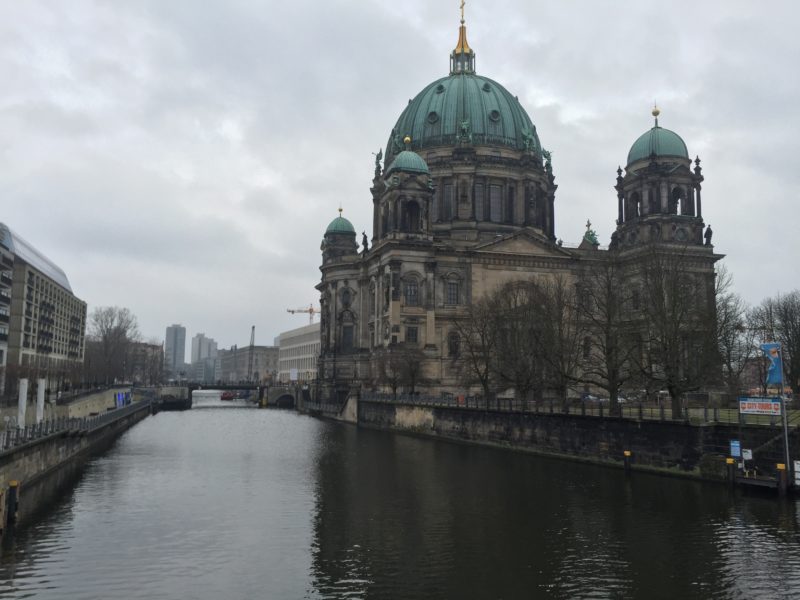
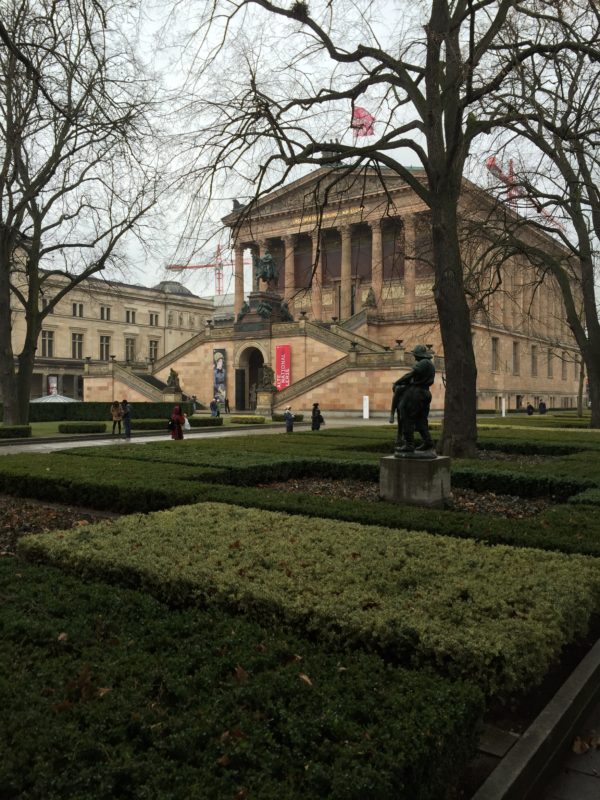
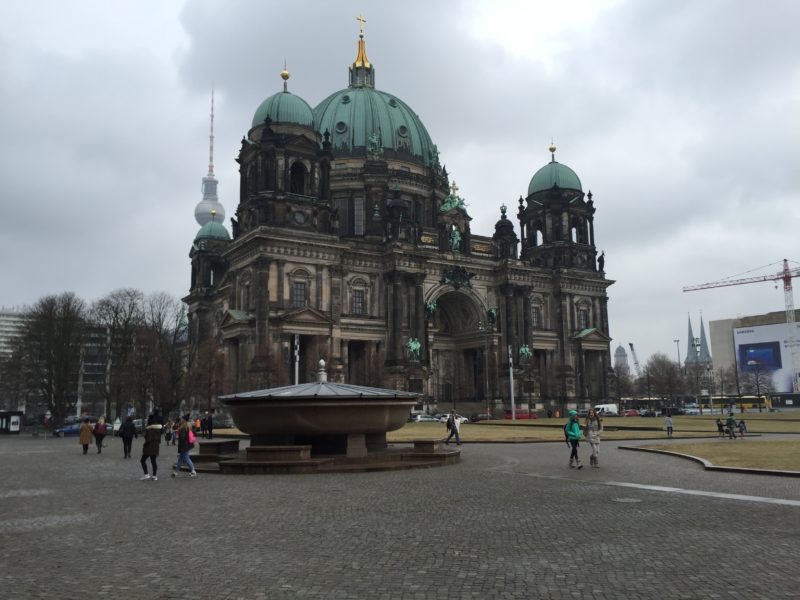

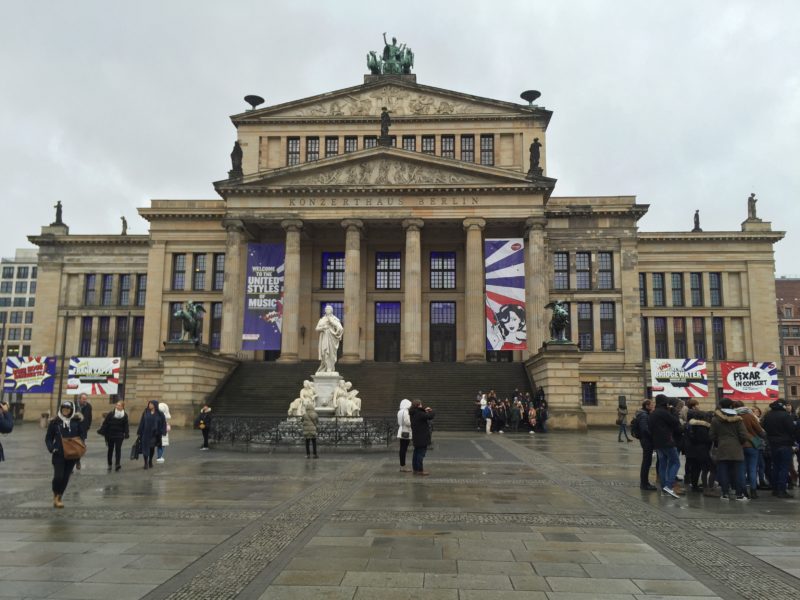

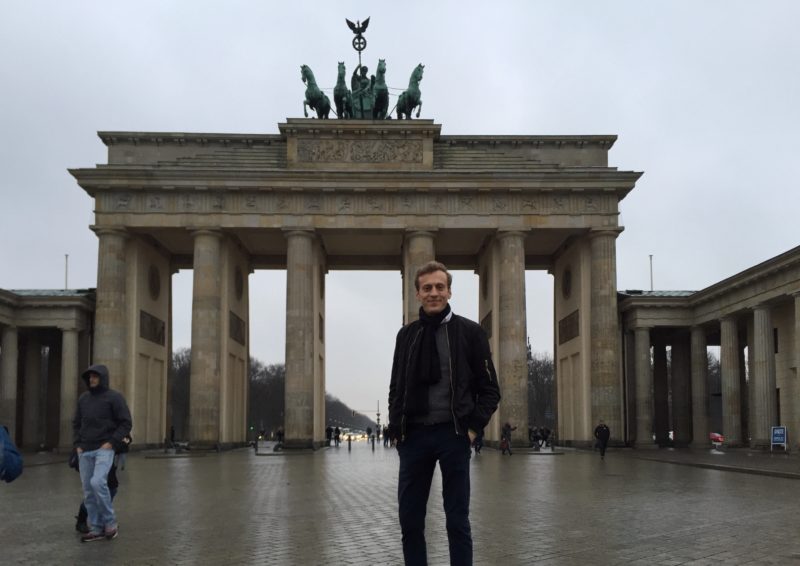
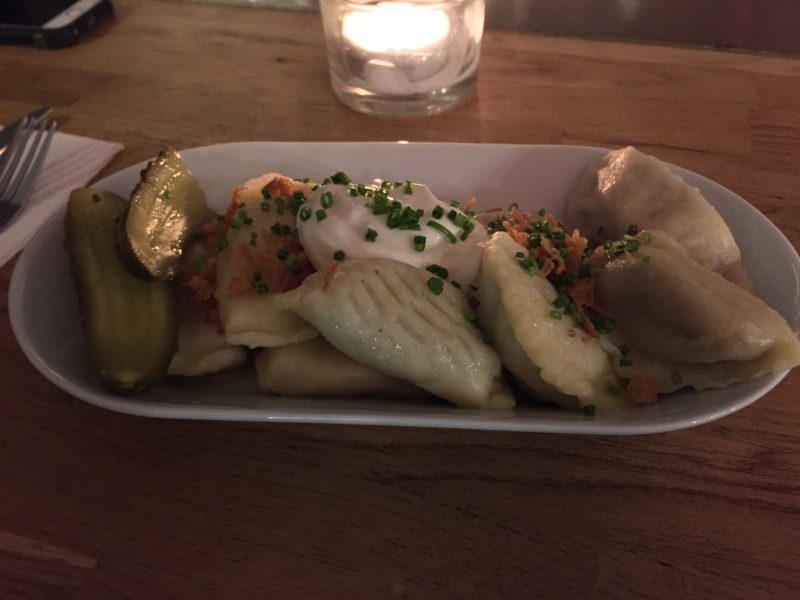
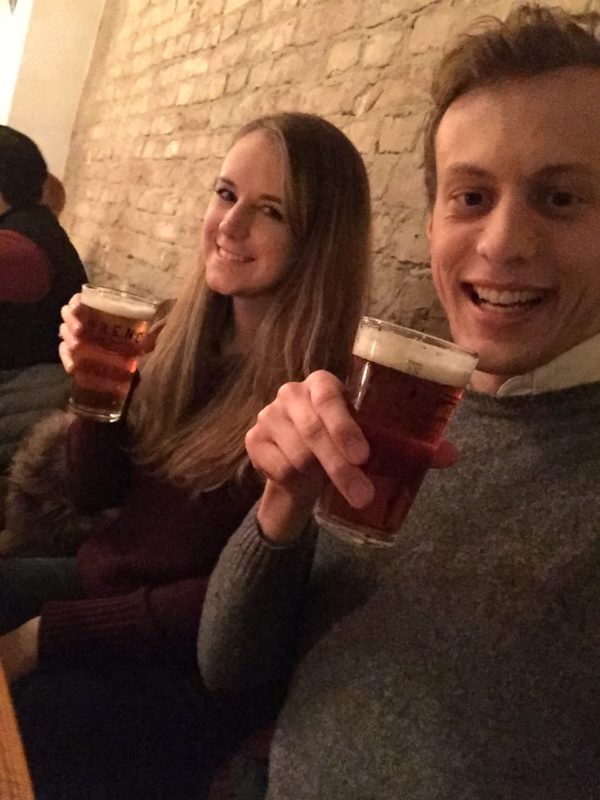
Day 2
The second day was filled mostly with the ~2.5 hour city tour we took. We decided on grabbing breakfast and then trying to make the 11 am tour. Breakfast Saturday was at Spreegold, where we both got the Canadian Pancakes: pancakes with bacon, grilled banana, and assorted fruit. Pancakes (and maple syrup) has been something I’ve really missed in Spain, so this breakfast made me quite the happy person.
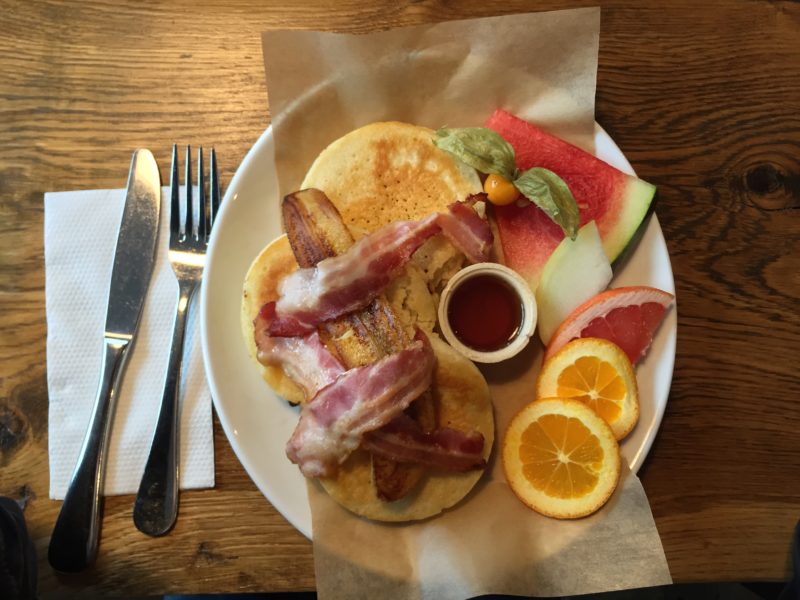
Next up was the tour, put on by SANDEMANs, a group that puts on amazing free tours in cities across Europe (we had previously done the Madrid tour when we first moved here and loved it). This time around our tour guide was Mark, a witty Brit that loved history. The tour focused on the history of Berlin through the ages. As most people should know, Berlin (and Germany) has had some dark times in history (as have most countries), but Mark was very upfront and straightforward about discussing the history and explaining all sorts of details, something a history buff like myself loved. He explained how it’s very important to discuss what happened, no matter how uncomfortable, to stay informed and prevent anything like the Holocaust ever happening again. Some of the tour highlights included:
- Pariser Platz, the plaza in front of the Brandenburg Gate which has held a variety of important events over the years, including Reagan’s famous 1987 “Tear down this wall!” speech. The platz houses the French and American Embassies and the famous Hotel Adlon, Berlin’s most luxurious hotel which is known as the site that Michael Jackson hung his son Blanket out of the window.
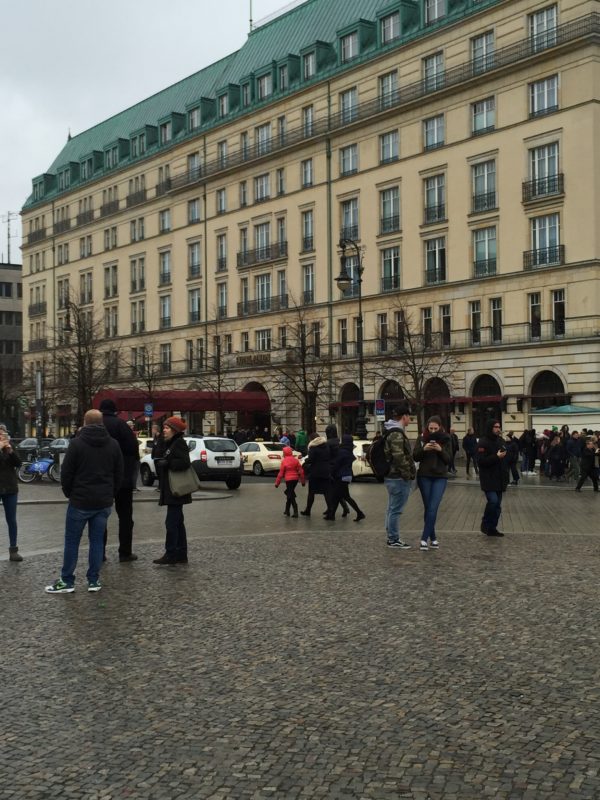
- The Brandenburg Gate, which was constructed in the late 1700s on the spot of the former city gate that led to Brandenburg. Over the ages the gate has been symbolic for a variety of reasons. Initially the gate symbolized power, as only the royal family could enter through it. Thus both the Napoleon’s iconic march through during his conquest, as well as Hitler and the Nazi Party’s use of the gate are important as they signified a change of power.
Later, at the end of World War II, the gate symbolized endurance and strength. While most of Berlin was bombed and destroyed during the war, the heavily-damaged gate managed to survive. After the construction of the Berlin Wall (which ran right behind the gate) it was a picture of division and separation for the duration of the Cold War. Finally, it’s became a symbol of peace and unity, not just for Germany but for Europe as a whole.
- The Memorial to the Murdered Jews of Europe, a famous memorial that contains 2,711 different concrete slabs. The entire memorial is on uneven, hilly ground, each block is a different height and at slightly different angles, and randomly has trees dispersed throughout. The architect has never offered an official meaning of the park, which Mark explained as a way to force people to think about the meaning and the holocaust as a whole. If you’re given the answer right away you aren’t forced to think deeply about an issue, which is an interesting inspiration for a park of such nature.
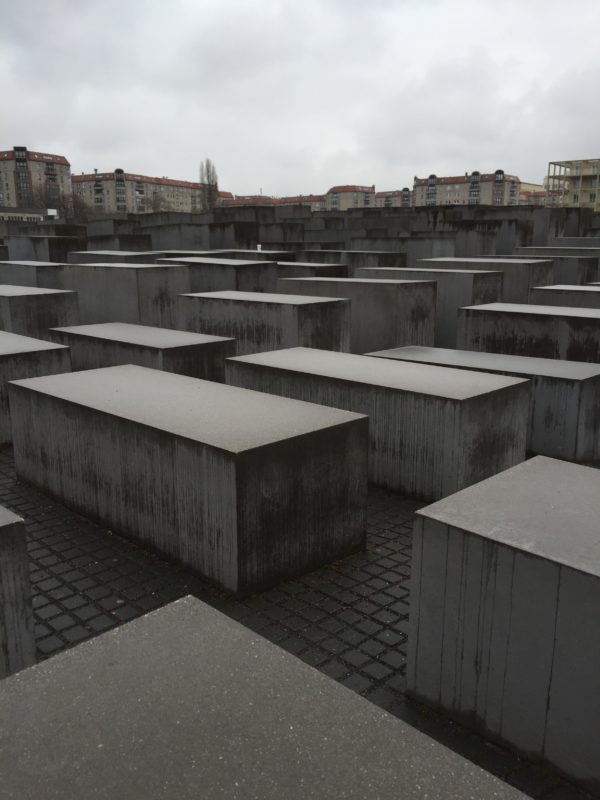
- Site of Hitler’s Bunker, which is notable simply because it’s not notable. The site is a random parking lot in between residential buildings. You would have no clue what is below you if someone didn’t tell you. All around the area stood the government buildings during the Nazi era, but everything was destroyed as a part of the denazification program. The Allied governments reasoned that if any buildings or Nazi symbols stood after the way they could be turned into shrines or places that inspired future generations of Neo-Nazis to gather and rebuild at. Similarly, across the street from the bunker is a small sandbox with a slide that is the supposed site that Hitler’s body was burned (all conspiracy theories aside). If the spot of the former leader was marked it could encourage others to turn him into a martyr and gather there, so all of this was kept secret.

- Federal Ministry of Finance, the only former Nazi government building the remain standing, and the best known example of Nazi architecture today. It was the headquarters of the Luftwaffe, the German Air Force responsible for the Blitzkrieg headed by Hermann Göring. After WWII ended and Berlin was split up it was the only intact, suitable government buliding in East Berlin, so it became the Eastern Berlin government building for the Soviets. After the reunification of Germany, and up until present time, it’s been the Ministry of Finance (the German IRS) and is still a hotly debated and protested building in Germany today. It’s one of the only buildings to go from Nazi usage to Soviet usage to it’s modern-day usage.
- Berlin Wall, which only has three sections remaining standing. After WWII and the subsequent split of Germany, many East Germans wanted to flee the Eastern communist Germany in favor of the Western capitalist Germany. Berlin was the easiest loophole, as there were no borders, so East Germans could cross into West Berlin, get a West Germany passport (almost overnight, in many cases), and then fly to West Germany from there.
Almost 3.5 million Germans immigrated to West Germany in this way (20% of the population), and this included many skilled workers and educated Germans, which significantly hurt East Germany’s economy. On August 12th, 1961, GDR officials signed off to close the border, and overnight the wall was erected. 13,000 soldiers erected a fence – literally overnight – surrounding all of West Berlin, and within the next week a more permanent wall was put into places. Families were split, border-crossing workers lost jobs, and the world would be changed significantly as the wall would stand 28 years until it’s fall in 1989.

- Checkpoint Charlie, the famous Berlin Wall border crossing point.

- Gendarmenmarkt, a square that houses the Berlin Konzerthaus and two churches. The Französischer Dom (French Church) was built in the 1700s as a signal of peace and unification; at the time many French people lived in Berlin and the Germans constructed these church that offered services in French. Across from it is the similar Deutscher Dom (German Church)
- Bebelplatz/Opernplatz, home of the world-renowned Humboldt University. On May 10th, 1933, a group of students from the Deutsche Studentenschaft walked out of Humboldt into the square and burned nearly 25,000 books during the famous Nazi book burnings, suppressing opposing thoughts and starting extreme State censorship in Germany.
Nowadays the square has a memorial to the book burnings. A glass pane in the ground looks down into a memorial, an empty library room with empty book shelves. It was quite muddy and foggy so it was a bit harder for us to get a look. A plaque nearby also has a chilling quote from Heinrich Heine:
“Das war ein Vorspiel nur, dort wo man Bücher verbrennt, verbrennt man am Ende auch Menschen.”
“That was only a prelude; where they burn books, they will in the end also burn people”
Wildly enough, that quote is from 1821, a century before the Nazi party’s emergence. The entire tour as a whole was extremely eye-opening. Regardless of political beliefs and opinions, a lot that’s going on today in our political has some parallels to a lot Ali and I saw on our tour, and it left us it deep thought for a while.
After the tour finished, we had a few places we wanted to hit up before daylight ended. We first took a walk past the Brandenburg gate into Berlin’s Tiergarten, Berlin’s largest park, and saw the famous Reichstag building, which houses the German Parliament. The other biggest remaining goal was to see the East Side Gallery, another intact portion of the Berlin Wall that’s been painted on by artists and muralists. The general theme revolves around peace, with much of the art featuring pieces about walls, doves, chains, and Cold War personage. We followed the entire wall, looking at the art and taking pictures, before heading across the river (walking across the Oberbaum bridge) into some more “hipster” neighborhoods. We stopped at Eliza, a small tea cafe for a cup of hot chocolate and chocolate chip cookies before grabbing dinner at The Pit, an American BBQ joint owned by a Texan who brought his grilling equipment straight from Texas. I ordered the 18-hour smoked beef brisket with some coleslaw and was thoroughly happy with the dinner choice.
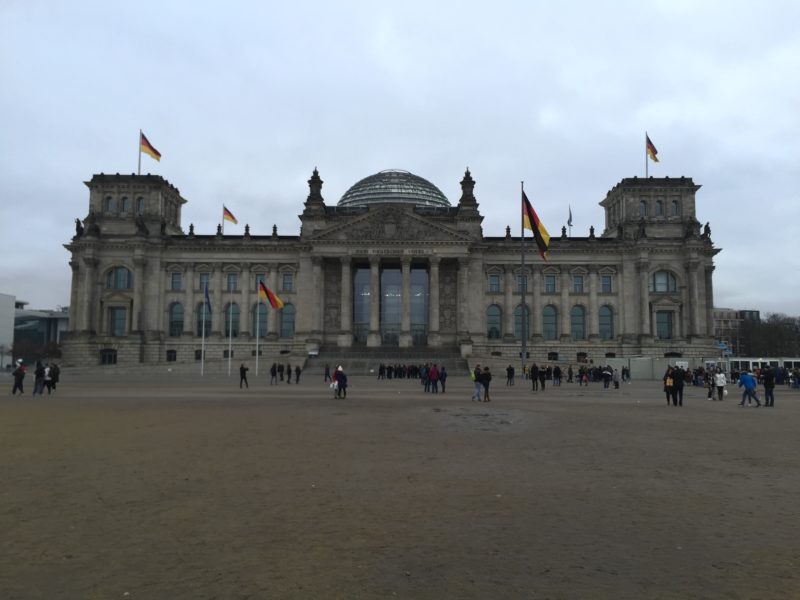

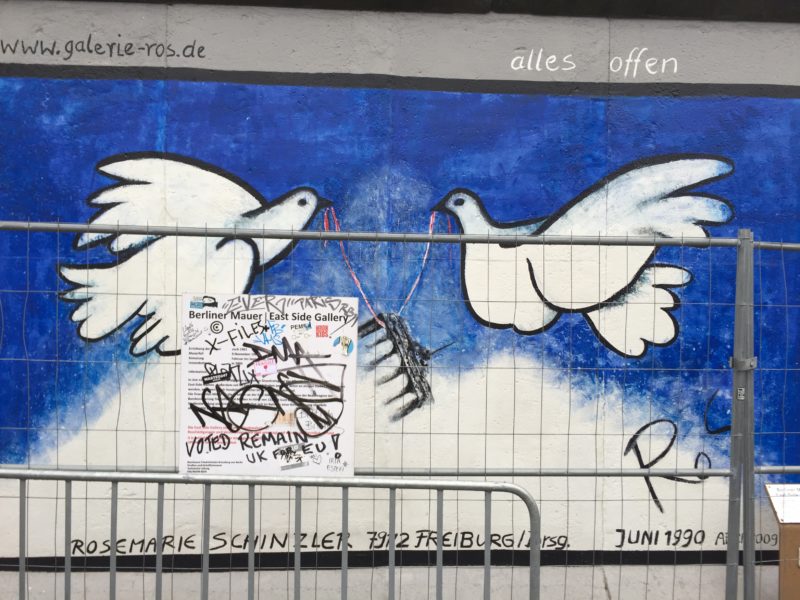
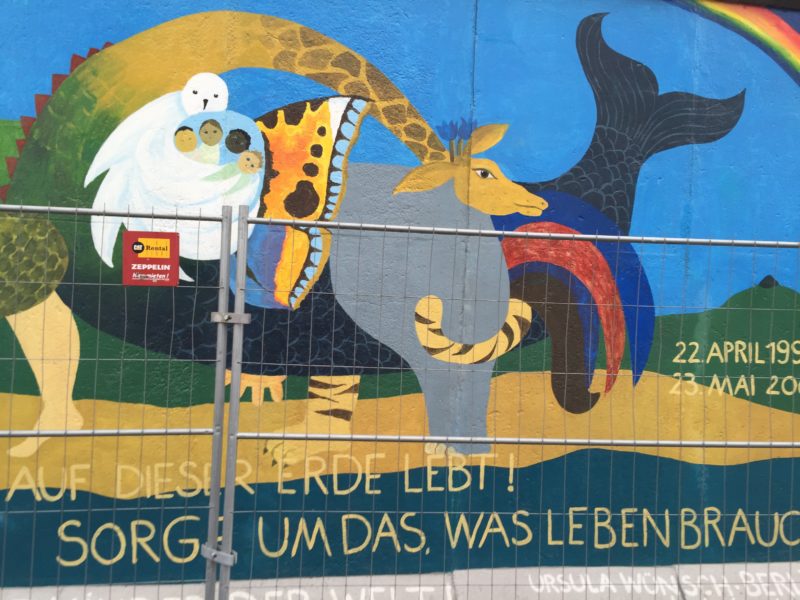
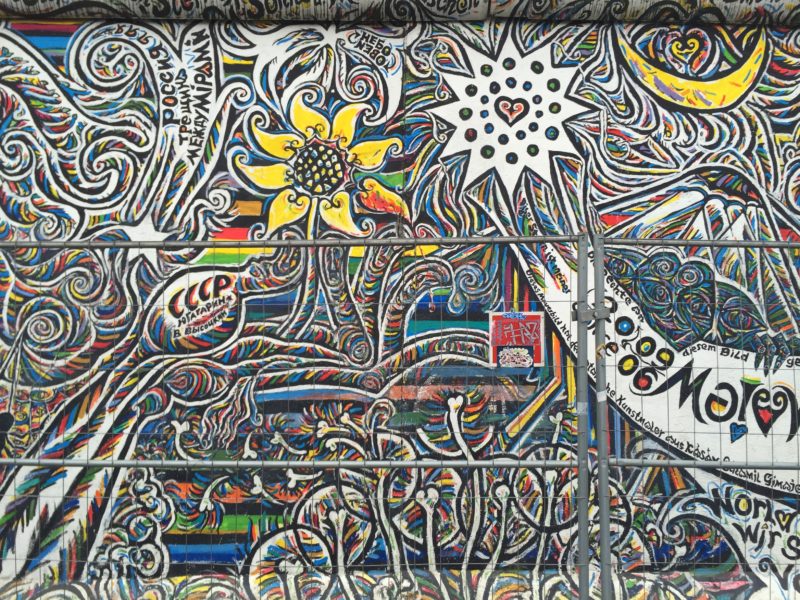

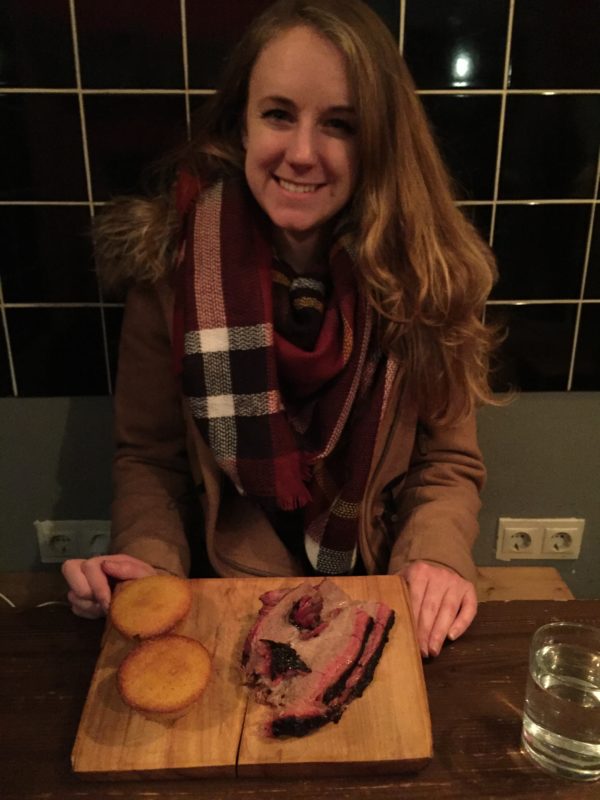
At this point Ali and I were freezing and it was nighttime, so we spent the last few hours in another map-recommended joint, Not Only Riesling, a cozy and upscale wine bar. Ali got a glass of a red Spanish-blend (ironic, I know) and I had a delicious glass of a German Riesling as we sat and talked over a platter of cheese, bread, olives, and spreads. The bar wasn’t too expensive and might have been my favorite place we visited on the trip.

Our plane flew out at 7.30 am on Sunday, but we had already checked out of our hostel (to save a night’s money), so the rest of the evening was a very long, uncomfortable wait to finally go home. The initial idea was to go out all night to bars and a club, but with Ali’s sickness she just wanted to rest as much as possible. We spent a few hours laying on couches in the hostel’s common room before heading to the airport around 4 am, and then spent a few more hours trying to sleep in the airport before finally going back to Madrid – and our own beds! All in all, the trip exceeded my expectations. Berlin seemed like a city I would love to spend a few months there, exploring every small cafe and restaurant. Hopefully I can go back sometime when it’s warmer – and greener!
Day 2 step count: 24.463 steps / 9.69 mi (15.59 km)


Holy Toledo, Mark, First of all thanks for the heads up. What a fantastic trip even though it was wet and cold. Lots of history and enjoyed seeing the buildings and the Berlin wall. Thanks for sharing. The food actually looks good and after all those steps, you may have to eat at least six meals a day. Are you training for marathons? We have had record temps for Feb. Sat it was 67 and it was at least 63 yesterday plus 60’s again today. I’m sure we will get colder weather again. We usually have a snow storm when March Madness is here. Who knows?????????? I think you need your mom to send you one of their ponchos:). Stay safe and healthy. Love hearing from you. My Love, Grandma Bernie
Mark, thank you for the wonderful tour of Berlin. Almost seems like I’ve been there now. You chose a wide variety of subjects to take pictures of. Guess your camera is top-notch, ’cause the pictures are so good. Sorry Ali became ill, and I hope she is OK by now and you are fine. Your are a lucky young man to see these places where your ancestors (of not too many generations ago) were born . I don’t think they ever went back to see Germany, except as soldiers. I hear you have a trip to see Rachel and Kevin also soon. Looking forward to another blog and pictures of that trip! Stay well and enjoy every day. Love you, Grandma L.